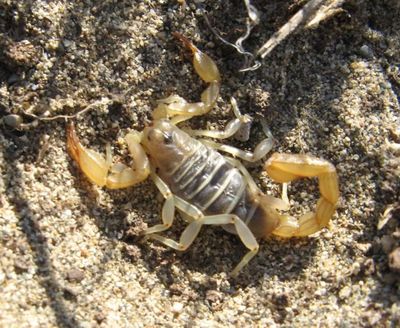Scorpions in Washington? Yep, and they even glow in the dark

Even if you do a lot of hiking or camping in Washington state, you’ve probably never encountered one of these critters feared by humans for their crayfishlike pincers and stinging tail. But as you can see by the photograph taken by Gary Lentz in Columbia County, scorpions live here. In fact, lots of them do.
Lentz found the medium-sized scorpion in sandy soil about 6 miles from the town of Starbuck early one May afternoon, he explained.
“I study reptiles and amphibians and was doing a search for them when I turned over a piece of dead sagebrush and there it was,” said Lentz, adding that he found several more the same day.
Since this column is bound to surprise a lot of readers, sit back and enjoy the ride.
Widely believed to be a strictly desert-dwelling creature, scorpions actually reside in all kinds of habitats, ranging from sand dunes and caves to mountains and rain forests. Of the roughly 100 scorpion species found in the United States, two are located in the Evergreen State, according to arachnid expert Rod Crawford of the University of Washington Burke Museum.
The species featured in Lentz’s photograph is P. boreus, short for Paruroctonus boreus, Crawford said. It is found “entirely east of the Cascades and is only common in treeless habitats,” he explained, living quietly in semi-arid, rocky or sandy areas.
Commonly known as the Northern scorpion, the adults are just under 2 inches long with a pale brown body and yellowish tail. Not surprisingly, Northern scorpions can withstand cooler temperatures than their kin residing in the Desert Southwest. Like all scorpions, P. boreus uses its two pincers to capture and hold prey, then stings it with the venom-packed stinger on its precisely striking tail.
That is precisely why humans view scorpions as sinister creatures, but they’re not, Crawford said. Of the more than 1,500 scorpion species known worldwide, only 30 produce venom potent enough to be life-threatening. P. boreus isn’t among them. “The sting of this species is strong enough to make you say ouch, but less painful than a bee or wasp sting and brief in its effect,” he explained.
It’s not as if scorpions seek a giant human foot to attack. They’re reclusive, Crawford said. Like spiders, they don’t attack humans unless threatened.
Should you spot a Northern scorpion in Eastern Washington, consider yourself lucky, not in danger. They hide under rocks or inside cracks during the day and come out when it’s dark to find a meal, which might include a beetle, grasshopper or stinkbug.
Under the cover of darkness, most scorpion species, including P. boreus, glow a vibrant blue-green color under the beam of ultraviolet light. Scientists aren’t sure why they possess this unusual trait. Some say it’s to protect them from sunlight. Others theorize it helps them find each other in the dark or confuse prey.
On the west side of the Cascades, Washington’s second scorpion species lives in forested areas, mostly in Skamania and Lewis counties. Uroctonus mordax, commonly known as the Pacific forest scorpion, is mostly found in the Cascade foothills areas, said Crawford, who has published studies on both species. Black-brown and about 2.1 inches long with its tail extended, U. mordax prefers more moisture than the Northern scorpion.
Scorpions are a great success story of evolution, according to published research. Dating back 440 million years in the fossil record, they are equipped with extraordinary survival skills and able to live in harsh environments and a variety of elevations.